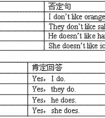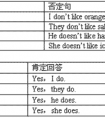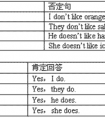用所给词的适当形式填空。 1. What (发生) now? 2. They help (互相) in their class. 3. He(认为) the ball was too heavy.4. Did you (过的愉快) today?5. He (教-七年级英语
F.子中有now时,常表示动作正在进行,这时要用现在进行时。如:
They are playing basketball now.现在他们正在打篮球。
G.ook, listen开头的句子,提示我们动作正进行,这时要用现在进行时。如:
Listen!She is singing an English song.听,她正在唱英语歌。
H.当前一段时间或现阶段正在进行的动作,且此时有this week, these days等时间状语,这时常用现在进行时。如:
We are making model planes these days.这些天我们在做飞机模型。
I.图片中的人物的动作,也为了表达更生动。此时也常用现在进行时。如:
Look at the picture. The children are flying kites in the park.看这幅图,那些孩子正在公园放风筝。
考点名称:可数名词(单数名词,复数名词)
- 可数名词:
是指能以数目来计算,可以分成个体的人或东西;
因此它有复数形式,当它的复数形式在句子中作主语时,句子的谓语也应用复数形式。 - 名词单数变复数的规则:
巧记以f\fe结尾的可数名词复数情况 构成方法 例词 读音 一般情况 在词尾加-s desk→desks
map→maps-s在清辅音后发/s/ day→days
girl→girls-s在元音和浊辅音后发/z/ 以s,x,ch,sh结尾的词 在词尾加-es bus→buses box→boxes watch→watches fish→fishes -es发/iz/音 以辅音字母加-y结尾的词 变y为i再加-es family→families
factory→factories
party→patries-ies发/iz/音 以元音字母加-y结尾的词 在词尾加-s day→days
boy→boys
key→keys-s发/z/音 以f或fe结尾的词 变f或fe为v再加-es knife→knives
life→lives
wife→wives
half→halves-ves发/vz/音 以辅音字母加-o结尾的词 在词尾加-es potato→potatoes
tomato→tomatoes
hero→heroes-es发/z/音 以元音字母加-o结尾的词 在词尾加-s radio→radios
zoo→zoos-s发/z/音
妻子骑牛拿起刀,wife,calf,knife ↑
追得贼狼满街跑,thief,wolf →→→变f或fe为v,再加es
碰倒架子丧己命,shelf,self,life ↓
手帕树叶半空飘。handkerchief,leaf,half ↓ - 名词复数的不规则变化:
1.不规则形式:
child→children(儿童)
man→men(男人)
woman→women (女人)
an Englishman→two Englishmen(英国人)
foot→feet(脚)
tooth→teeth(牙)
mouse→mice(老鼠)
ox →oxen(公牛)
goose→geese(鹅)
2.单复同形:
deer,sheep,fish,Chinese,Japanese, species,means,Swiss
除人民币,美元、英镑、法郎等都有复数形式。
如:a dollar,two dollars; a meter,twometers
3.集体名词,以单数形式出现,但实为复数:
people police cattle是复数
(OK :a person,a policeman,ahead of cattle,the English,the British,the French,the Chinese,the Japanese,the Swiss )
(Error:a people,a police,a cattle )
表示国民总称时,作复数用。
(The Chinese are industries and brave. 中国人民是勤劳勇敢的。)
4.以s结尾,仍为单数的名词
maths,politics,physics等学科名词,为不可数名词,是单数。
news是不可数名词。
5.表示由两部分构成的东西,
glasses(眼镜) trousers (长裤) clothes(衣服)
若表达具体数目,要借助数量词pair(对,双)a pair of glasses two pairs of trousers suit(套)
6.另外还有一些名词,其复数形式有时可表示特别意思
goods (货物) waters (水域) fishes (各种鱼) - 可数名词变复数的几种形式:
1) 单数名词加s: students, apples, bags, trees, books, brothers.
2) 以s、x、sh、ch结尾的名词加es: glasses, boxes, brushes, matches.
3) 以辅音字母加y结尾的名词,变y为i加es: cities, babies, enemies.
4) 以f或fe结尾的名词,多数变f为v加es: wives, knives.但有些词只加s: roofs,proofs, chiefs.
5) 以o结尾的名词,有些加es: Negroes, heroes, tomatoes, potatoes. 其它加s: radio s, zoos, pianos, photos.
6) 不规则名词:foot→feet, goose→geese, tooth→teeth, child→children, man→men, woman→women, mouse→mice.
7) 单复数同形的名词:sheep,fish,dee.
注意:fish表示种类时,也用fishes这样的形式。
考点名称:相互代词
- 相互代词:
就是表示相互关系的代词。它与它所指代的名词或代词是一种互指关系,因此它们是复数或者二者以上。
英语中的相互代词只有两个,即each other和one another。
在正式文体中多用each other指两者,用one another指两者以上。
我们应当把它们当作复合代词看待,即使在分开使用时,它们也是相互关联的。
在句中,相互代词可用作宾语、定语等。例如:
Don't talk to each other (one another).
We must help one another. - 相互代词的用法:
相互代词只有each other和one another两个词组。他们表示句中动词所叙述的动作或感觉在涉及的各个对象之间是相互存在的,例如:
It is easy to see that the people of different cultures have always copied each other.
显而易见,不同文化的人总是相互借鉴的。
相互代词的句法功能:
a. 作动词宾语;
We often help each other in our lessons.
我们经常在功课上互相帮助。
They see one another every day.
他们每天见面
b. 可作介词宾语;
Does bark, cocks crow, frogs croak to each other.
狗吠、鸡鸣、蛙儿对唱。
说明:传统语法认为,相互关系存在于两个人或物之间用each other,存在于两个以上人和物之间用one another。
现代英语中,两组词交替使用的实例也很多,例如:
He put all the books beside each other.
他把所有书并列摆放起来。
He put all the books beside one another.
他把所有书并列摆放起来。
Usually these small groups were independent of each other.
这些小团体通常是相互独立的。
c.作定语时须用所有格
The students borrowed each other's notes.
学生们互借笔记。 相互代词each other和one another的区别:
1. 一般认为 each other 指两者,other another指三者或三者以上。但在实际运用中,这两个短语常可互换:
We respect each other [one another]. 我们互相尊重 (对方)。
The sea and the sky seemto melt into one another [each other]. 大海和蓝天似乎融为一体。
2. 两者均有所有格:They know each other’s [one another’s] weak points. 他们都彼此了解对方的缺点。
3. each other 可折开用 (each…the other),而 one another则不能:
We helped each other. =We each helped the other. 我们互相帮助。
4. 汉语的“互相”是副词,但是英语中的 each other 和 oneanother均为代词,因此在及物动词之后可直接用作宾语 (如help eachother);
而在不及物动词之后,则要借助介词 (如talk to each other, learn from one another 等)。
5.这两个短语均不能用作主语:
正:We each know what the other thinks.
误:We know what each other [one another] thinks.
正因为不能用作主语,所以用它们作宾语的句子不能改为被动语态。
考点名称:实义动词的过去式
- 表示一般过去式的动词通常用动词的过去式形式来表示,而动词的过去式是在动词原形的基础上变化的。
动词的过去式可分为规则动词和不规则动词。 实意动词过去式变化规则:






